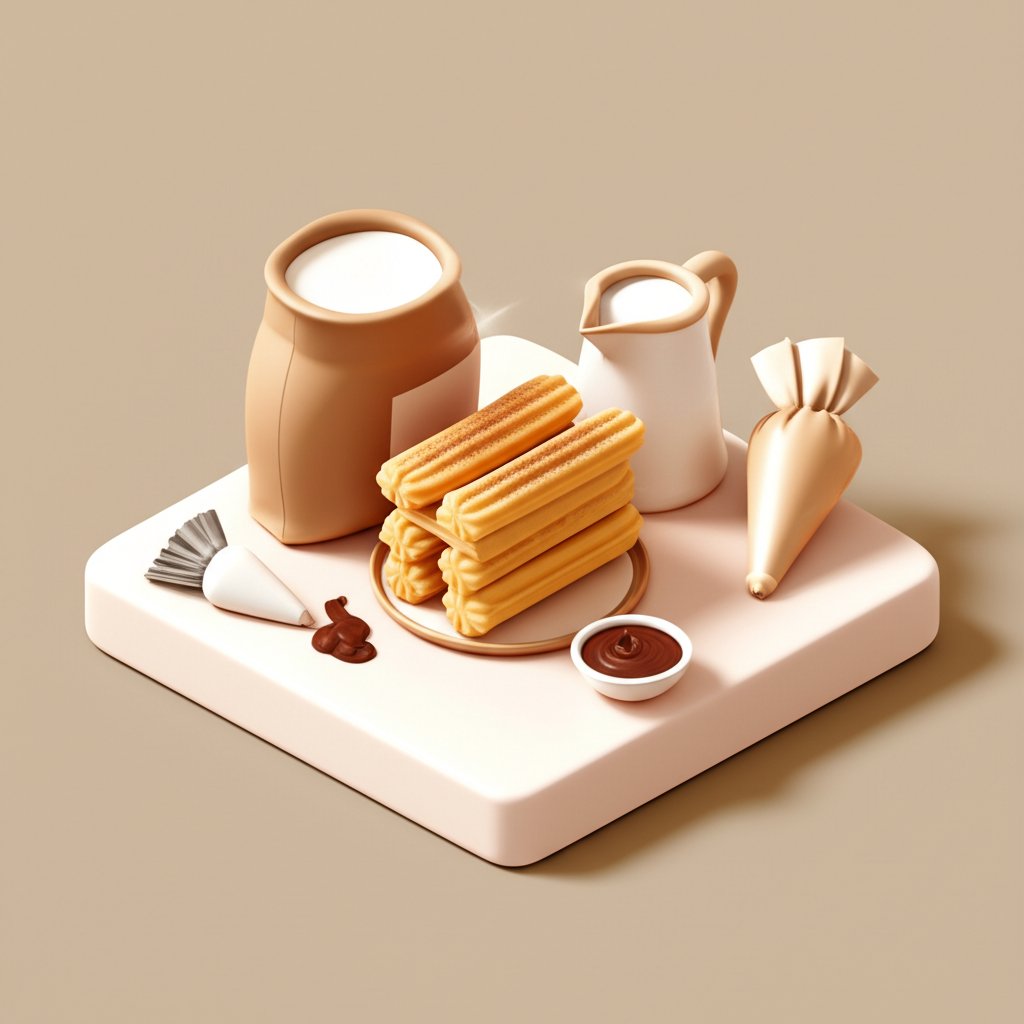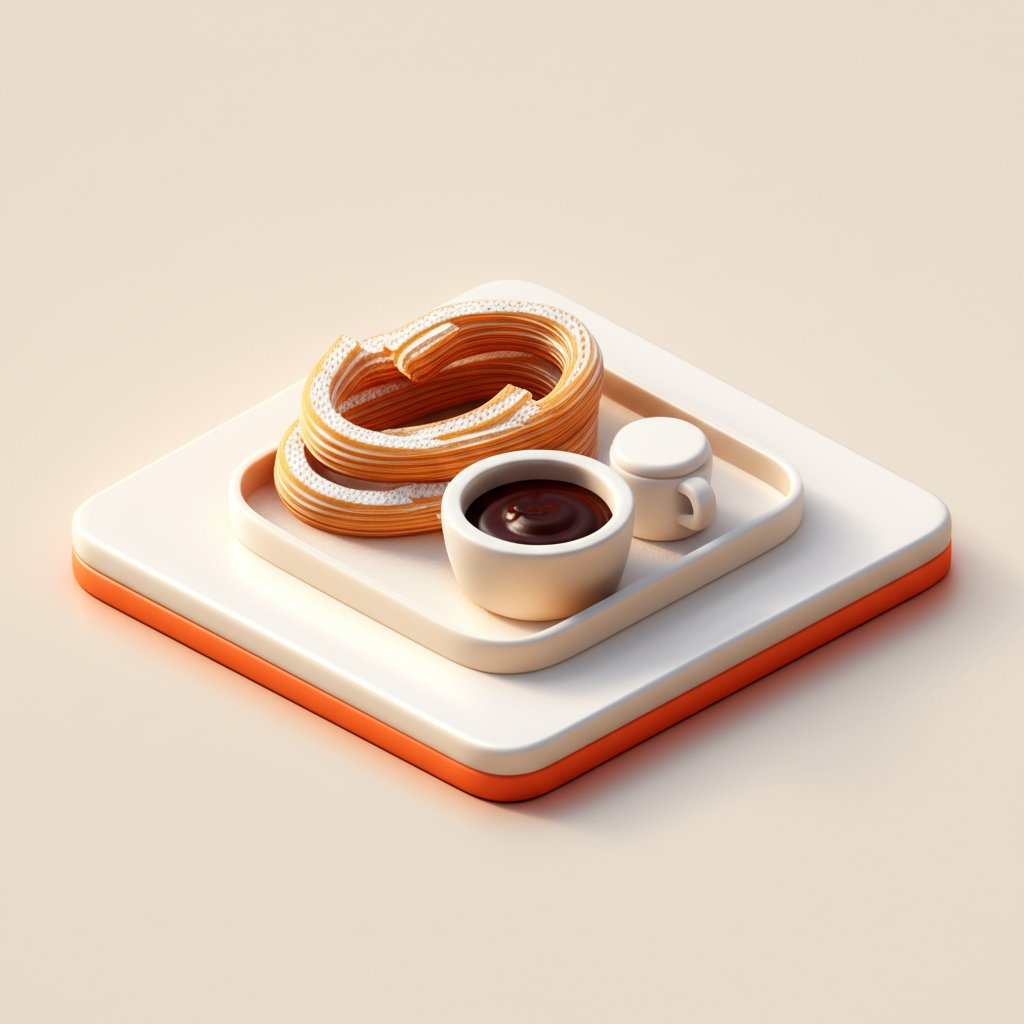Imagine the warm, inviting aroma of freshly fried dough, delicately crisp on the outside, wonderfully soft on the inside, dusted with cinnamon sugar. This isn’t just a fantasy; it’s the sensory delight of traditional Spanish churros. Beloved across Spain and the world, these iconic pastries are more than just a sweet treat – they’re a culinary experience deeply rooted in culture and tradition. While they might seem like a delicacy reserved for skilled chefs, mastering the authentic churros recipe is entirely within your reach.
In this ultimate guide, we’ll strip away the complexity and reveal the time-honored secrets behind the true churros cooking method. From selecting the right ingredients to perfecting the frying technique, you’ll learn how to make churros that rival those found on the bustling streets of Madrid. Prepare to embark on a delicious journey that will transform your kitchen into a Spanish bakery and elevate your dessert game to world-class status.
The Essence of Traditional Spanish Churros: A Culinary Journey

Before we dive into the practicalities, let’s appreciate the heritage of traditional churros. These delightful fried dough pastries hold a special place in Spanish culture, often enjoyed for breakfast with a cup of thick hot chocolate or as a late-night snack. They are distinct from their Latin American counterparts, often simpler in ingredients and served plain or with chocolate for dipping.
To truly appreciate the magic you’re about to create, perhaps explore the rich history of churros and its origins before you begin frying, for a deeper understanding of this delightful treat.
The beauty of spanish churros lies in their humble origins and straightforward list of ingredients: flour, water, salt, and oil for frying. No eggs, no yeast, just a perfect choux-like dough that, when expertly fried, achieves that quintessential light, airy interior and golden, crunchy exterior. Understanding this simplicity is the first step to truly mastering the churros recipe. It’s a testament to how basic components can yield extraordinary flavor when the churros cooking method is respected.
Gathering Your Arsenal: Ingredients & Equipment for the Perfect Churros Recipe

Success in any culinary endeavor begins with preparation. For an authentic churros recipe, you don’t need exotic ingredients, but quality and precision are key.
Essential Ingredients for Traditional Churros
- All-Purpose Flour (2 cups / 250g): The backbone of your churros. Sifting it ensures a smoother dough and helps prevent lumps, contributing to that delicate texture.
- Water (1 1/4 cups / 300ml): The primary liquid. It needs to be boiling hot to properly cook the flour and create the choux pastry base.
- Salt (1/2 teaspoon): Crucial for enhancing the flavor of the dough. Don’t skip it!
- Granulated Sugar (2-3 tablespoons for the dough, plus 1/2 cup for coating): A small amount in the dough for subtle sweetness, and a generous amount for the iconic cinnamon-sugar coating.
- Cinnamon (1-2 tablespoons for coating): Pairs perfectly with the sugar for that classic churro finish.
- Vegetable Oil (4-6 cups for frying): Choose a neutral-flavored oil with a high smoke point, such as sunflower, canola, or light olive oil. The quantity needs to be sufficient for deep-frying.
Crucial Equipment for How to Make Churros
- Heavy-Bottomed Pot or Dutch Oven: Essential for deep-frying. Its heavy construction helps maintain a consistent oil temperature, which is vital for the
churros cooking method. - Deep-Fry Thermometer: Non-negotiable! Maintaining the correct oil temperature (350-375°F / 175-190°C) is the most critical factor for perfect churros. Too cold, and they’ll be greasy; too hot, and they’ll burn outside and be raw inside.
- Pastry Bag and Star Nozzle: A sturdy pastry bag fitted with a large star tip (like a Wilton 1M or similar open star) is necessary to create the characteristic ridged shape of
spanish churros. These ridges increase the surface area for crispiness and help cook the churros evenly. A churrera (churro maker) is also an excellent alternative if you plan to make them often. - Slotted Spoon or Spider Skimmer: For safely transferring churros in and out of hot oil.
- Paper Towels: For draining excess oil after frying.
- Whisk and Wooden Spoon: For mixing the dough.
- Measuring Cups and Spoons: For accurate ingredient quantities.
Mastering the Churros Cooking Method: A Step-by-Step Guide
Now, let’s get into the heart of how to make churros, focusing on the authentic churros cooking method. Precision and timing are your best friends here.
1. Preparing the Dough: The Foundation of Your Churros Recipe
The dough for traditional churros is a simple choux pastry, cooked first on the stovetop. This step is crucial for developing the right texture.
- Boil the Water: In a medium saucepan, combine the water, 2-3 tablespoons of granulated sugar, and salt. Bring this mixture to a rolling boil over medium-high heat.
- Add the Flour (All at Once!): Once the water is boiling fiercely, remove the pan from the heat. Immediately add all the sifted flour into the hot water mixture.
- Stir Vigorously: Using a sturdy wooden spoon, stir quickly and continuously until the flour is fully incorporated and forms a cohesive ball of dough that pulls away from the sides of the pan. This process cooks the flour, forming a pliable dough. It should be thick and slightly stiff.
- Rest the Dough (briefly): Allow the dough to rest in the pan for 5-10 minutes. This helps it cool slightly, making it easier to handle and preventing potential mishaps during piping and frying.
2. Piping Perfection: Shaping Your Spanish Churros
The distinctive ridged shape is what makes spanish churros so recognizable and contributes to their crispy texture.
- Prepare Your Piping Bag: Fit a strong pastry bag with your large star nozzle. If you’re using a churrera, prepare it according to its instructions.
- Fill the Bag: Carefully transfer the slightly cooled churro dough into the prepared pastry bag. Do not overfill; work in batches if necessary. Twist the top of the bag to seal the dough.
- Safety First: Before piping, ensure your frying oil is heating up to the desired temperature (350-375°F / 175-190°C). Never pipe dough into cold or insufficiently hot oil.
- Pipe into Hot Oil: Holding the bag firmly, pipe 5-7 inch long strips of dough directly into the hot oil. Use kitchen shears or a small knife to cut the dough cleanly from the nozzle. Work in small batches to avoid overcrowding the pot, typically 3-4 churros at a time, depending on your pot size. This is a critical part of the
churros cooking method.
3. Deep Frying with Finesse: The Churros Cooking Method Unveiled
Frying is where the magic happens, transforming raw dough into golden, crispy traditional churros.
- Maintain Temperature: Continuously monitor your oil temperature with the deep-fry thermometer. Fluctuations can lead to soggy or burnt churros.
- Fry Until Golden: Fry the churros for 2-4 minutes per side, or until they achieve a beautiful golden-brown color and are thoroughly cooked through. Turn them gently with your slotted spoon or spider to ensure even browning.
- Drain Excess Oil: Once perfectly golden, remove the churros from the oil and place them on a plate lined with paper towels to drain any excess oil. This step is essential for crispiness.
Achieving Churro Perfection: Frying Techniques & Troubleshooting
The path to exquisite traditional churros can sometimes have bumps. Here’s how to navigate common challenges and ensure consistently perfect results.
Essential Frying Techniques for How to Make Churros
- Oil Temperature is King: As mentioned, maintaining 350-375°F (175-190°C) is paramount. If the oil is too cool, the churros will absorb too much oil and become greasy. If too hot, they will brown too quickly on the outside, remaining raw in the center. A reliable thermometer is your best friend.
- Don’t Crowd the Pot: Frying too many
spanish churrosat once will drop the oil temperature significantly, leading to uneven cooking and greasiness. Fry in small batches and allow the oil to return to temperature between batches. - Even Cooking: Flip the churros halfway through frying to ensure both sides are beautifully golden and crisp.
- Safe Handling: Always use a slotted spoon or spider to carefully place and remove churros from the hot oil. Wear an apron and exercise caution to avoid splatters.
Troubleshooting Common Churro Challenges
- Soggy Churros:
- Cause: Oil not hot enough, or overcrowding the pot.
- Solution: Ensure oil is at the correct temperature (350-375°F) and fry in smaller batches. Drain thoroughly on paper towels immediately after frying.
- Burnt Outside, Raw Inside:
- Cause: Oil too hot.
- Solution: Reduce oil temperature to the correct range.
- Churros Exploding While Frying: This is a serious safety concern.
- Cause: Too much moisture trapped inside the dough, or inconsistencies in the dough. This often happens if eggs are added to a traditional water-based choux pastry, or if the dough is too wet. The steam builds up and forces a rupture. Also, if there are air pockets.
- Solution:
- Stick to the
traditional churros recipe: No eggs are used in the classic Spanish churro dough. - Ensure dough consistency: The dough should be thick and stiff after cooking on the stovetop.
- Use a star nozzle: The ridged shape helps steam escape evenly, reducing the risk of explosions.
- Even piping: Try to pipe the dough consistently to avoid weak spots and large air pockets.
- Do not overmix the dough after it cools slightly.
- Stick to the
- Churros Losing Shape:
- Cause: Dough too wet, or oil not hot enough.
- Solution: Ensure dough is firm, and oil is at the correct temperature for immediate setting.
The Grand Finale: Coating, Serving, and Enhancing Your Spanish Churros
Your traditional churros are almost ready for their grand debut! The final touches make all the difference.
The Classic Cinnamon-Sugar Coating
- Mix the Coating: In a shallow dish, combine the remaining 1/2 cup of granulated sugar with 1-2 tablespoons of ground cinnamon. Adjust the cinnamon to your preference.
- Coat While Warm: Immediately after draining the fried churros, while they are still warm, roll them generously in the cinnamon-sugar mixture. The warmth helps the sugar adhere perfectly, creating that irresistible crust.
Serving Your How to Make Churros Masterpiece
Spanish churros are best enjoyed fresh and hot. The crispy exterior and tender interior are most pronounced right out of the fryer.
- Traditional Dipping Chocolate: The quintessential accompaniment for
traditional churrosis a thick, rich, bittersweet hot chocolate, often so dense it’s more like a pudding. Dunking a warm churro into this molten chocolate is a truly divine experience. - Other Dipping Sauces: While chocolate is classic, feel free to explore other delicious options:
- Dulce de Leche: A creamy, caramelized milk sauce, popular in Latin American churro traditions.
- Caramel Sauce: A sweet, buttery classic.
- Fruit Compotes: A fresh berry compote can add a lovely tart contrast.
- Plain and Simple: Many purists enjoy
traditional churrossimply coated in cinnamon sugar, appreciating the pure flavor of the dough.
Exploring Variations of the Churros Recipe
While this guide focuses on the traditional churros recipe, there are a few delightful variations you might encounter or wish to try:
- Porras: A larger, thicker, often smoother Spanish fried dough, typically without the star shape. They are often lighter and fluffier than churros.
- Churros Rellenos: While less traditional in Spain, many Latin American cultures fill churros with dulce de leche, chocolate, or fruit jellies after frying. To do this, you would use a special churro filler tool.
- Savory Churros: For an adventurous twist, omit the sugar from the dough and coating, and serve with savory dips like a spicy cheese sauce or a garlic aioli.
Conclusion: Savoring the Tradition of Homemade Spanish Churros
Congratulations! By following this comprehensive churros recipe and mastering the nuances of the churros cooking method, you’ve unlocked the secret to creating authentic traditional Spanish churros right in your own kitchen. This isn’t just about making a dessert; it’s about embracing a cherished culinary tradition, sharing warmth and flavor with loved ones, and experiencing the pure joy of a perfectly crafted treat.
The next time you crave an irresistible snack, remember how to make churros the traditional way. Gather your ingredients, prepare your equipment, and let the simple magic of flour and water transform into golden, crispy perfection. Your journey to spanish churros mastery begins now – get frying and savor every delicious bite!
FAQ: Your Top Questions About Traditional Churros Answered
Q1: What makes a churro “traditional” as opposed to other versions?
A1: Traditional churros, particularly those found in Spain, are typically made with a simple dough of flour, water, and salt (sometimes a touch of sugar). They are often egg-free and yeast-free, resulting in a slightly denser, chewier interior with a very crispy exterior. They are usually piped with a star nozzle for ridges and served plain with cinnamon sugar or alongside thick, hot chocolate for dipping. Many Latin American versions may include eggs, milk, or butter in the dough, and are sometimes filled with dulce de leche or chocolate after frying.
Q2: Is the oil temperature truly that important for the churros cooking method?
A2: Absolutely! The oil temperature is arguably the most critical factor for a successful churros cooking method. If the oil is too cool (below 350°F / 175°C), the churros will absorb too much oil, becoming greasy and heavy. If it’s too hot (above 375°F / 190°C), the exterior will brown and crisp too quickly, while the inside remains raw and doughy. A deep-fry thermometer is essential for maintaining the ideal temperature range.
Q3: Can I use an air fryer or bake spanish churros for a healthier option?
A3: While you can technically air fry or bake churros, the results will not be the same as traditional deep-fried spanish churros. The high-heat, quick-frying churros cooking method is what gives them their unique crispy exterior and tender, airy interior. Air-fried or baked versions may be crisp, but they often lack the same light texture and rich flavor profile achieved through deep-frying. For an authentic experience, deep-frying is recommended for this churros recipe.
Q4: Why did my churros recipe dough explode in the oil? This commonly happens when I how to make churros.
A4: Churros exploding in hot oil is a serious safety concern and usually indicates trapped moisture or air within the dough that turns to steam and bursts out. This can happen if:
traditional churros: Authentic Spanish churros do not contain eggs. Adding eggs to a water-based dough can increase the risk of explosions due to trapped moisture.Q5: How far in advance can I make the churro dough?
A5: For the best results and texture, it’s recommended to fry traditional churros immediately after preparing the dough. However, if you must prepare it in advance, the dough can be made, cooled, and stored in an airtight container in the refrigerator for up to 1-2 days. You might need to let it come to room temperature slightly before piping, and the texture may be marginally different from freshly made dough.
Q6: What’s the best oil to use for frying traditional churros?
A6: For the churros cooking method, choose a neutral-flavored oil with a high smoke point. Good options include sunflower oil, canola oil, vegetable oil, or light olive oil. Avoid extra virgin olive oil as its smoke point is too low for deep frying and its flavor can be overpowering.










